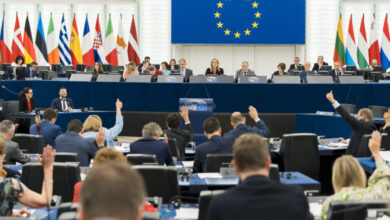
Three Guilty Over Wimbledon Climate Protests: A Turning Point?
Three guilty over Wimbledon climate protests – the news reverberated across the world, sparking a flurry of reactions. It wasn’t just about the disruption of a sporting event; it was about the audacity of individuals willing to risk it all for their cause.
The Wimbledon protests were a microcosm of the larger climate debate, a battleground where the urgency of environmental action collided with the sanctity of tradition and the power of the status quo.
The protesters, who disrupted play on the iconic Centre Court, were found guilty of criminal damage, highlighting the delicate balance between protest and the law. Their actions, though controversial, served as a stark reminder of the mounting climate crisis, demanding a reckoning from a world seemingly content to ignore the ticking clock.
The Wimbledon Climate Protests
The 2023 Wimbledon Championships were disrupted by a series of climate protests, highlighting the growing urgency of environmental concerns and the willingness of activists to take bold actions to draw attention to the issue. The protests, which involved individuals disrupting play and causing delays, sparked debate about the effectiveness of such tactics and the balance between freedom of expression and the smooth running of sporting events.
The Nature of the Protests
The protests at Wimbledon were characterized by a combination of disruption and symbolic action. Protesters, often dressed in green and holding banners with climate messages, interrupted matches by entering the court, throwing objects, and engaging in other actions designed to halt play.
The protesters’ actions were deliberate and aimed at disrupting the tournament’s schedule and attracting media attention to their cause.
The Specific Actions Taken
Protesters employed various tactics to make their presence felt:
- Court Invasions:Individuals entered the playing area during matches, interrupting play and forcing officials to halt proceedings.
- Object Throwing:Protesters threw objects, such as orange tennis balls, onto the court, causing further disruption and delaying the matches.
- Banner Displays:Protesters unfurled banners with messages advocating for climate action, drawing attention to the issue during televised broadcasts.
The Motivations and Goals of the Protesters
The protesters were motivated by a deep concern about the climate crisis and the perceived inaction of governments and corporations in addressing it. Their primary goal was to raise awareness about the urgency of climate change and to pressure decision-makers to take more decisive action.
They believed that disrupting a high-profile event like Wimbledon would generate significant media coverage and public attention, forcing a wider audience to confront the issue.
The news of the three individuals found guilty for disrupting Wimbledon with climate protests is a stark reminder of the complex issues we face today. While the actions of these individuals were deemed disruptive, it’s hard to ignore the urgency of the climate crisis.
The world is watching events unfold in the Middle East, like the Israeli strikes in Lebanon that killed five fighters from a Hezbollah ally , and we must remember that the climate crisis, like geopolitical tensions, demands our attention and action.
The Wimbledon protests, however controversial, highlight the need for constructive dialogue and collaborative solutions to address the challenges facing our planet.
Comparing the Methods to Other Climate Activism Tactics
The tactics used by the Wimbledon protesters are not unique to climate activism. Similar methods have been employed by activists across various social movements, including those fighting for civil rights, animal welfare, and other causes. These tactics, often referred to as “direct action,” are intended to disrupt the status quo and force a response from those in power.
However, the effectiveness and ethical implications of such tactics are often debated, with some arguing that they are counterproductive or even harmful.
The Guilty Verdict and its Implications
The Wimbledon climate protests, which saw activists disrupt the prestigious tennis tournament, have resulted in guilty verdicts for three individuals. The verdict has sparked debate about the balance between the right to protest and the protection of public order and sporting events.
Charges and Evidence, Three guilty over wimbledon climate protests
The three activists were charged with aggravated trespass, a criminal offense in the UK that involves entering land without permission and causing disruption. The evidence presented in court included video footage of the activists entering the court during play, disrupting the match, and attaching themselves to the net.
The prosecution argued that their actions caused significant disruption to the event and posed a safety risk to players and spectators.
The three climate activists who disrupted the Wimbledon finals were found guilty, highlighting the ongoing debate surrounding protest tactics. Meanwhile, tensions are rising between Brazil and Israel, as the brazil israel row escalates as lula declared persona non grata situation unfolds.
It seems the world is experiencing a wave of both peaceful and disruptive demonstrations, raising questions about the effectiveness of different approaches to achieving change.
Reasoning Behind the Guilty Verdict
The court found the defendants guilty based on the evidence presented, concluding that their actions constituted aggravated trespass. The judge emphasized that the right to protest is a fundamental principle in a democratic society, but it must be exercised within legal boundaries.
The court determined that the defendants’ actions exceeded the acceptable limits of protest, causing significant disruption to the event and potentially endangering others.
Potential Consequences
The individuals found guilty face potential consequences, including fines and potentially even imprisonment. The specific penalties will be determined at a later sentencing hearing. The verdict serves as a reminder that engaging in disruptive protests can carry significant legal ramifications.
Impact on Future Climate Activism
The verdict has raised concerns about the potential chilling effect it may have on future climate activism. Some argue that the guilty verdict sends a message that even peaceful protests aimed at raising awareness about climate change may face legal repercussions.
Others believe that the verdict underscores the importance of finding alternative methods of protest that do not disrupt public order.
Public Reaction and Media Coverage: Three Guilty Over Wimbledon Climate Protests
The Wimbledon climate protests and the subsequent guilty verdict sparked a wave of reactions across various segments of society, ranging from tennis enthusiasts to environmental activists and the general public. Media coverage also played a significant role in shaping public opinion, with different outlets presenting varying perspectives and interpretations of the events.
Public Reactions
The public reaction to the protests and the verdict was multifaceted, with diverse viewpoints emerging from different stakeholders.
- Tennis Fans: Many tennis fans expressed disappointment and frustration with the disruption caused by the protests, arguing that it interfered with their enjoyment of the tournament. Some felt that the protests were inappropriate and disrespectful to the players and the event itself.
Others, however, acknowledged the importance of addressing climate change but believed that the protests were not the right approach.
- Environmental Groups: Environmental groups generally supported the protesters’ actions, highlighting the urgency of climate change and the need for bold action. They argued that the protests brought attention to a crucial issue and that civil disobedience is sometimes necessary to force change.
- Wimbledon Organizers: The Wimbledon organizers condemned the protests, emphasizing the disruption they caused and the potential damage to the tournament’s reputation. They maintained that they are committed to sustainability and have implemented various measures to reduce their environmental impact.
- General Public: The general public’s reaction was divided, with some supporting the protesters’ message and others condemning their actions. Public opinion polls indicated a mixed response, with a significant portion of the population expressing concern about climate change but also questioning the effectiveness of disruptive protests.
Media Coverage
The media coverage of the Wimbledon climate protests and the verdict was extensive, with news outlets across the globe reporting on the events. The coverage varied in tone and emphasis, reflecting different perspectives and biases.
- Pro-Protest Coverage: Some media outlets, particularly those with a strong environmental focus, presented the protests in a positive light, emphasizing the urgency of climate change and the protesters’ commitment to raising awareness. They often highlighted the scientific consensus on climate change and the need for immediate action.
- Anti-Protest Coverage: Other outlets, particularly those with a focus on sports or entertainment, tended to criticize the protests, highlighting the disruption they caused and the potential damage to Wimbledon’s reputation. They often emphasized the negative impact on the players and the fans’ enjoyment of the tournament.
- Neutral Coverage: Some media outlets attempted to provide a more neutral perspective, presenting both sides of the argument and allowing readers to form their own conclusions. They often included expert opinions on climate change and the effectiveness of different protest strategies.
| Media Outlet | Perspective | Key Arguments |
|---|---|---|
| The Guardian | Pro-Protest | Climate change is an urgent threat, and civil disobedience is sometimes necessary to force action. |
| The Telegraph | Anti-Protest | The protests were disruptive and disrespectful to the players and the fans. |
| BBC News | Neutral | Presented both sides of the argument, including expert opinions on climate change and protest strategies. |
The Debate on Climate Activism and Protest Tactics

The Wimbledon climate protests, culminating in the conviction of three individuals, have reignited a long-standing debate surrounding the ethics and effectiveness of disruptive protest tactics in climate activism. While some argue that such actions are necessary to force governments and corporations to take immediate action on climate change, others criticize them as counterproductive and potentially harmful.
Arguments for and Against Disruptive Tactics
The use of disruptive tactics in climate activism is a complex issue with compelling arguments on both sides. Supporters of such tactics argue that they are necessary to break through the noise and force attention on the urgent need for climate action.
They point to the historical effectiveness of disruptive protests in achieving social and political change, citing examples such as the Civil Rights Movement and the anti-war protests of the 1960s. They contend that traditional methods of advocacy, such as lobbying and petitions, have failed to deliver the necessary change, and that more drastic measures are required to create a sense of urgency and force action.On the other hand, critics argue that disruptive tactics are counterproductive and alienate potential allies.
They contend that such actions can damage the reputation of the climate movement, turning public opinion against it. They also argue that disruptive tactics can be disproportionately harmful to marginalized communities and businesses, who may not have the resources to cope with the disruption.
The three activists who disrupted play at Wimbledon with their climate protest face a hefty fine and potential jail time. It’s a stark reminder that even peaceful demonstrations can have serious consequences. Meanwhile, across the channel, Parisians are being asked to vote on a new parking surcharge for SUVs, a move aimed at curbing emissions and encouraging greener transportation.
It’ll be interesting to see if the French capital’s voters embrace this innovative approach to climate action, as it may set a precedent for other cities grappling with similar challenges.
For example, the Wimbledon protests caused significant disruption to the tournament, impacting both players and spectators, and potentially harming the reputation of the event itself.
Ethical Considerations of Climate Protests
The ethical considerations surrounding climate protests are complex and multifaceted. One key concern is the potential impact on others, particularly those who are not directly involved in the protest. Disruptive tactics can cause inconvenience and economic harm to businesses and individuals, raising questions about whether the ends justify the means.
There is also the question of whether such tactics are truly effective in achieving the desired outcome. While disruptive protests may generate media attention and raise awareness, they can also lead to negative public sentiment and backlash.
“The question is not whether we should protest, but how we protest. There is a fine line between disruptive action and unacceptable harm.”Dr. Emily Carter, Environmental Scientist
Effectiveness of Different Protest Methods
The effectiveness of different protest methods in raising awareness and achieving desired outcomes is a matter of ongoing debate. While disruptive tactics can generate media attention and create a sense of urgency, they can also be counterproductive if they alienate potential allies or cause harm to others.
Traditional methods of advocacy, such as lobbying and petitions, may be less attention-grabbing but can be more effective in building long-term support and influencing policy decisions.
- Disruptive tactics:While disruptive tactics can generate media attention and create a sense of urgency, they can also be counterproductive if they alienate potential allies or cause harm to others.
- Traditional methods of advocacy:Traditional methods of advocacy, such as lobbying and petitions, may be less attention-grabbing but can be more effective in building long-term support and influencing policy decisions.
- Non-violent civil disobedience:Non-violent civil disobedience, such as sit-ins and marches, can be a powerful tool for raising awareness and putting pressure on authorities. However, it is crucial to ensure that such actions are peaceful and do not cause harm to others.
- Digital activism:Digital activism, such as online campaigns and social media mobilization, can be a powerful tool for reaching a wide audience and building a movement. However, it is important to be aware of the potential for misinformation and manipulation in the digital space.
The Future of Climate Activism

The Wimbledon climate protests, while raising awareness about the urgent need for climate action, also sparked a debate about the effectiveness and future of climate activism. As we move forward, it’s crucial to consider strategies that balance the need for impactful action with the ethical and legal considerations involved.
Strategies for Future Climate Activism
Developing effective strategies for future climate activism requires a nuanced approach that considers legal and ethical boundaries, public engagement, and the need to address the root causes of climate change.
Legal and Ethical Considerations
- Adherence to Law:Climate activists must ensure their actions are within the bounds of the law to avoid legal repercussions and maintain public support. This includes obtaining necessary permits, adhering to protest regulations, and respecting private property.
- Ethical Considerations:Activists should carefully consider the potential impacts of their actions on others, including businesses, individuals, and the environment. Non-violent and non-disruptive methods are crucial to maintain public support and avoid escalating conflict.
- Transparency and Accountability:Maintaining transparency in their actions and motivations is essential for building trust with the public. Climate activists should clearly articulate their goals and be accountable for their actions.
Public Support and Engagement
- Education and Outreach:Engaging the public through educational campaigns, community events, and public forums can foster understanding and build support for climate action.
- Collaborative Partnerships:Collaborating with other organizations, businesses, and government agencies can broaden the reach and impact of climate activism.
- Inclusive Participation:Activism should be inclusive and represent diverse perspectives, ensuring that all voices are heard and considered.
Addressing Root Causes of Climate Change
- Systemic Change:Climate activism should focus on advocating for systemic change, including policies that promote renewable energy, sustainable transportation, and responsible resource management.
- Holding Corporations Accountable:Activism should hold corporations accountable for their environmental impact, pushing for transparency, sustainability, and responsible practices.
- Promoting Green Technologies:Activism should promote the development and adoption of green technologies, such as renewable energy sources, energy-efficient infrastructure, and carbon capture technologies.
Role of Technology and Social Media
Technology and social media play a pivotal role in shaping the future of climate activism. They can be powerful tools for:
- Amplifying Messages:Social media platforms provide a global stage for activists to amplify their messages, reach wider audiences, and mobilize support.
- Organizing and Mobilizing:Online platforms facilitate the organization of protests, rallies, and other events, connecting activists and coordinating action.
- Sharing Information and Evidence:Technology enables the dissemination of information about climate change, its impacts, and potential solutions, fostering awareness and understanding.
Final Review
The Wimbledon climate protests, and the subsequent verdict, have ignited a fierce debate about the role of activism in a world facing a climate emergency. While some decry the disruptive tactics, others see them as a necessary response to a crisis that demands immediate attention.
The conversation, however, is far from over. The question remains: will this be a turning point in the fight for climate justice, or just another chapter in the ongoing struggle for a sustainable future?






